

Overview
Pamela Smith worked for Atari in the Promotion Design department for Consumer Electronics from 1982 – 1984. She designed the holiday packaging for the 5200 game console, and the retail point-of-purchase and sales support materials for the Ms. PacMan, DigDug, Pengo and Phoenix games. She worked with the team that designed and produced the 1983 sales catalogs, including the 2600 and 5200 video game consoles and the entire line up of games.
Pamela has worked as a graphic designer for over 30 years. Her previous employers include Landor Associates, Maxtor Corporation and Medtronic Inc. She has consulted for Apple Computer, Borland International, Brocade, Hewlett-Packard, and VMWare. Her work has received awards from Communication Arts, The Art Directors Club of New York, Creativity Magazine and POPAI.
Power-ups:
• Won 2nd prize at the 1983 San Francisco Ad Club Point-of-Purchase show in the mobile and counter card categories for Ms. PacMan.
• Lives in San Jose, CA with her husband Jerry and American Eskimo dog Rosie.
What was your first computer you owned and is that your favourite computer or do you have a different favourite?
The first computer I owned was a Apple Mac IIci. The year was 1990, I bought it through an employee discount program when I worked as a graphic designer/art director for the Santa Cruz Operations (SCO) located in Santa Cruz, CA. The price for the computer, along with a monitor and keyboard, was a around $4,000 — more than most computers today!
My favorite computer is the one I use now, which is my trusty MacbookPro Laptop. When at home, I use it with my awesome 27” Apple Thunderbolt Display.
What did you want to do when you were at school for a career and what was your first job?
I always wanted to be an artist but I didn’t know what kind. For the first 2 years of college I majored in Fine Arts, learning Art History and to draw and paint. My first job during that time was as a waitress at Farrell’s Ice Cream Parlour. When I wasn’t waitressing I was hand lettering large signs for the restaurant in old fashioned turn of the century style typefaces, to go along with the theme and design of an old time Ice Cream Parlour.
It wan’t until one of my professors suggested that I check out the graphic design program at the The Art Center College of Design, in Pasadena CA, that I got on the right path. I graduated with a BA with honors in Graphic Design and Packaging.
What and when was your first design job?
I was quite fortunate that I was recruited right out of art school by the design firm Landor Associates. Landor was a top tier international brand and design agency with their home office in San Francisco. It was located on a refurbished ferry boat docked in the water at Pier 5. I worked in the tobacco, beverages, and spirits group. The work was great, but what a combination—tobacco, beverages, spirits, and, to top it all off, Dramamine. To tell the truth, I really DID need Dramamine, because I get motion sickness easily. And it was a REAL boat! Waves and all.
Some of the work you may be familiar with occurred, just as I joined the company. All of the designers, and there were about 100 of us, were tasked to develop a new logo for the auto company Datsun. Their new name . . . NISSAN. I also did numerous sketches for a rebrand of Miller Beer and designed cigarette packages for Philip Morris.
How did you end up working for Atari?
Even though it was a great opportunity to work for one of the world’s best branding agencies at Landor, and I enjoyed the craft and creativity of designing cigarette packages, I couldn’t put aside my concerns about smoking. After all, I had watched my mother succumb to the effects of smoking, and it affected me deeply.
One weekend while attending a party with a group of Art Center alumni, someone told me about a job opening at Atari. I figured it had to be better than a job doing graphic design that encouraged smoking. The next day, I mailed my resume to Atari, and that same week Atari asked me to come in for an interview. To my surprise, I got the job! I gave my notice at Landor and started working at Atari two weeks later.
What was your first day at Atari like?
My first day as a staff designer was so exciting! I joined an orientation along with 100 other newly hired people. It seemed like things at Atari was doing really well!
What was your first project for Atari?
Good question, . . . humm, I’m not sure, I think it might have been a mobile and shelf talker for the game Phoenix.
Was it easy to fit in at Atari and who was the first person who made you feel welcome?
It was very easy to fit into Promotion/Design Department of the Consumer Electronics Division of Atari. We were a team producing a large amount of creative promotional material for Atari’s marketing efforts. And we were lucky enough to be artists who inspired and encouraged each other to produce the best we could. Unfortunately, I never got a chance to meet any of the game programmers at the time I worked there, they were in another building about a mile away.
The first person who made me feel welcome was my supervisor Elaine Wilson. She took the time to introduce me to everyone in the department and help me get my cubicle and equipment set up. However, the next day reality set in . . .
What was it like to work at Atari?
I was working in the trenches, head down, elbows out, in my own microcosm of the marketing efforts of Atari—making a small contribution to the success of Ms. Pac-Man, Dig Dug, Pengo, and Phoenix, as well as the Atari systems—2600, 5200, 7800, and their peripherals.
The marketing push was intense. We ran like any typical ad agency—fast and hard. Before trade shows or during product launches, days started early, and ended very late. I recall missing Thanksgiving Holiday dinner, while preparing for one of the early Consumer Electronics Shows in Las Vegas.
The pace was so frantic, that I’m sorry to say I never had the chance to take a break in the arcade room to let off steam playing Atari games. However all that hard work paid off with some great promotional retail materials that I’ll be sharing with you, for the consumer electronics division.
All in all, it was a great experience—even with its demands and eventual disappointment. What was unique about that time, was the way graphic designers worked then compared to now. It was different, in almost every way, except for the basic designer’s tools, which are creative thinking, talent, and a deep appreciation and understanding, of the principles of design.
It was the age before this age. It was pre-Macintosh computer (the preferred computer of most designers) / pre-internet / pre-social media. And, everything I did was done on the drawing board. In fact, if I had to start over on a project, I could actually say “Oh well, back to the drawing board.” I guess today I would say “Oh well, Command Z.” Or for the Windows folks, “Control Z”.
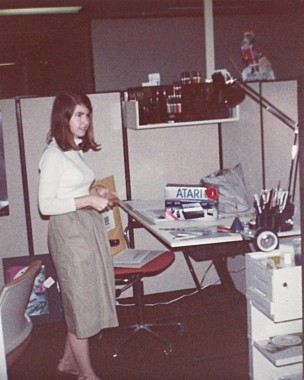
Here is a photo of me in my Atari cubicle. Sorry about the mess. We used markers and colored pencils to develop our ideas. We had T-squares and Rapid-O-Graph pens, to produce camera-ready art, to send to the printers and magazines. We marked up our content with exacting specifications, and sent it via courier, to typesetting shops that would turn around the styled type galleys overnight. We art directed photographers and illustrators, rather than going online to buy stock photography and art.
What is the funniest thing that happened to you at Atari?
The funniest (weird, not funny ha ha) thing that happened to me was being asked to design a holiday package for the 5200 gaming system.
In 1983 the Atari consumer electronics division found itself in an awkward position. They thought the 5200 gaming system was going to be a hot item for the holiday season. That was the good news. The bad news was that they also knew the 5200 was not going to be ready in time for the holidays. It became our mission to come up with a way to make it possible for people to give the 5200 as a holiday gift. The solution came about in stages.
First—I designed a box that had a photo of the 5200 printed on it, along with a festive red bow and ribbon. Just the ticket to put the happy recipient in the holiday spirit.
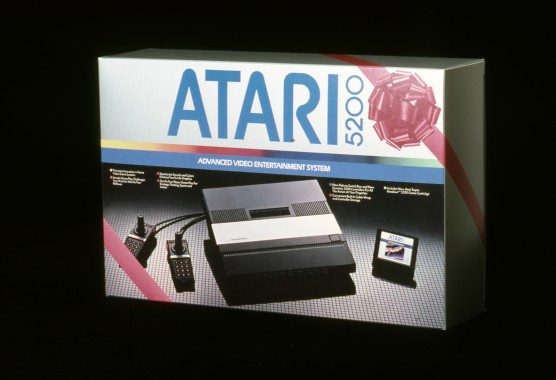
Next—I designed a “Congratulations” card that would sit inside the box that didn’t actually contain the Atari 5200 System.

The final step was to design a retail counter card promoting the 5200, and giving information about how people could give the gift, as a kind of IOU. These are some of my concept/exploration sketches.
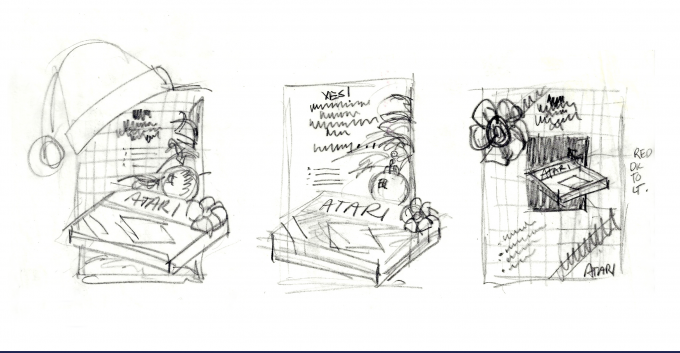
And here is the final counter card.
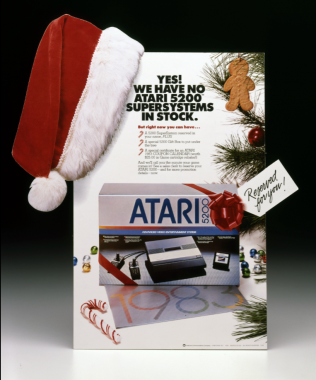
The box was delivered to the retailers shrink wrapped, flat, with instructions on how to assemble the “raincheck” gift boxes.
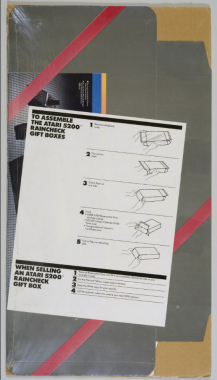
By the way, I just want to let you know, I am sorry if we made any of you cry when you got this gift in 1983. And I hope the system arrived soon after, and the whole affair was quickly forgotten.
What is the most frustrating thing that happened to you at Atari?
Remember early in this interview, that I mentioned about my first day at Atari, and how I was in an orientation meeting along with 100 other people? Well . . . the most frustrating thing that happened was being laid off only a year after I started. On February 22, 1983, Atari laid off 1,700 employees. I remember that because that it is the day before my birthday! We were all called into a town hall type meeting and told we were all laid off. They even had the unemployment office come and set up tables around the perimeter of the auditorium so we could all sign up immediately for unemployment benefits. They gave us no notice of the impending layoff. As far as I knew Atari was doing well and then, bam, they said that they were laying us off and moving most of it’s manufacturing to Hong Kong and Taiwan.
1983 became known as the year of the North American Video Game Crash was also known as Atari Shock in Japan.
To be truthful, I was both frustrated and also excited at losing my job. I was going to get a vacation after all the my hard work. But, alas, my vacation was cut short. Just a week after we were laid off, I and a few others from the marketing department were called back to work for another year. I came back as a consultant and was paid much better than I was on salary! Whoo Hoo!
After the year was up, we were let go permanently. Atari Corp., which bought the assets of Atari Inc. in 1984 no longer manufactured video games. There were several reasons for the crash, but the main cause was saturation of games and consoles on the market. But, luckily for all you video game lovers out there, The North American video game console industry recovered a few years later, mostly due to the success of the Nintendo Entertainment System (NES).
What is the favourite art you have worked on during your time at Atari?
My favourite projects I worked on were for the point of purchase Ms PacMan counter card and mobile. But I couldn’t have done it without the help of Gus Allen who brilliantly illustrated the package cover for the 2600 game. I used his cover illustration as inspiration to go a step further and design the motorized counter card and mobile artwork. I used Ms Pac-Man exactly as she was on the package. I then asked Gus to illustrate a moon for Ms Pac-Man to sit on, and illustrate the ghosts, Blinky, Pinky, Inky and Clyde with their eyes looking up at her instead of down like on the package. BTW, the Ms PacMan game for the 2600 console was a much better version than the disappointing PacMan version for the 2600. MsPacMan was much more like the original Namco arcade game.
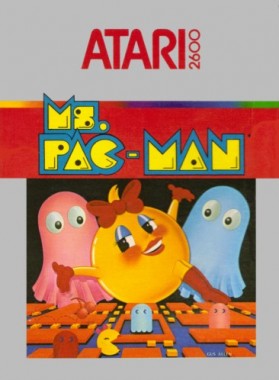
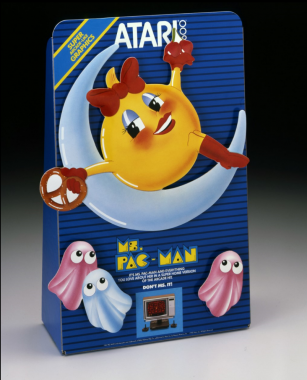
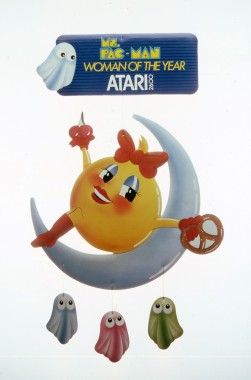
I wish I still had my original sketches for Ms Pac-Man like I do for some of my other projects, but we only had a half a day to clean out our desks after the layoff and unfortunately lost a lot of my original sketches.
Please tell me what your role was during your time at Atari ?
During the time I was at Atari, my title was Graphic Designer. My role was to design point of purchase materials, also known as sales support items, including mobiles, easel cards, aisle displays and brochures. These were strategically placed in stores where consumers made their purchase. They were designed to work their magic by influencing the final buying decisions. I worked with copy writers, to come up with concepts. I usually started with loose sketches. Then I would tighten up the sketches to make color marker comprehensives, or comps, as they were called, to present to the project manager. I sometimes worked directly from finished package illustrations which were done by the Consumer Graphics department under the direction of John Hayashi. The Illustrators were housed in another building, just like the programmers. Other times I art directed illustrators to follow my concepts from scratch, such as in the game Phoenix. I also art directed photo sessions with photographers for ads, sales guides, sales binders, etc.
These are samples of pieces I worked on for the game, Phoenix. This set of sketches are for a shelf talker. Working from the illustration on the packaging for the Phoenix game, was not a simple proposition. The illustrated Phoenix would be a challenge to apply to the projects I was working on, which were a mobile and a shelf talker. So instead I imagined something bolder, that was recognizable as the classic Phoenix.

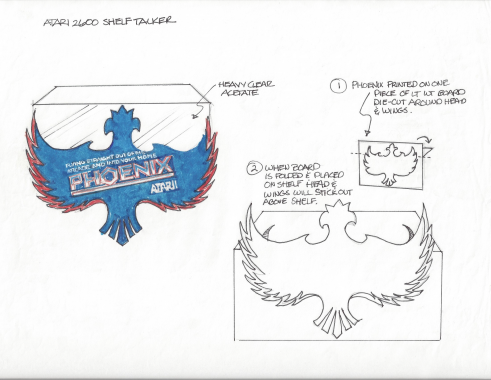
Our POP rep from PacLitho and I collaborated when I showed him a rough pencil comp of what the Phoenix could look like. Together, we came up with this for the final shelf talker.

And “cudos” to PacLitho, for the mobile. Once again I worked with their rep. This is an example of paper engineering genius. I loved those guys!
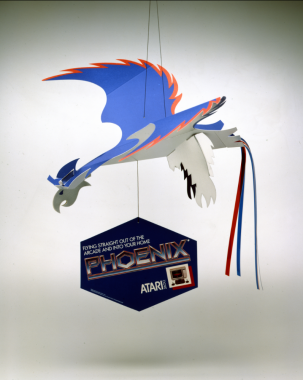
Please tell us about when you won 2nd prize at the 1983 San Francisco Ad Club
Point-of-Purchase show in the mobile and counter card categories for Ms. PacMan?
All our late nights and hard work paid off with awards and acknowledgements for our team. None of us in the department knew that our work was submitted to the San Francisco Ad Club Point-of-Purchase Show, so we didn’t attend the awards show. It turned out that I was the surprised recipient of the two second place prizes for the Ms. Pac-Man mobile and the Ms. Pac-Man motorized counter card and only found out that I won 2nd place after the event.
Here is an article from an Atari newsletter that talks about all the awards that Atari won. As you can see in the photo on the first page, my friend and co-worker, Jan Davis won first place in the counter card category for the game E.T. floor card. She worked in the international Marketing and Sales Graphic Design Group. Even though the E.T. game wasn’t a winner in the market place, at least it was in retail design! More on that subject later.
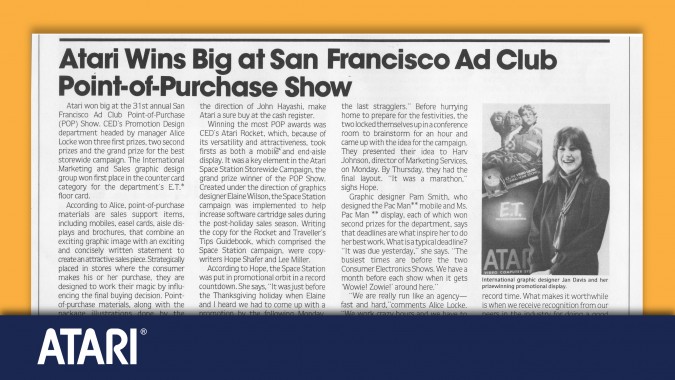
The second page shows our whole group. I am in the back row, the forth person from the left, and 33 years younger.
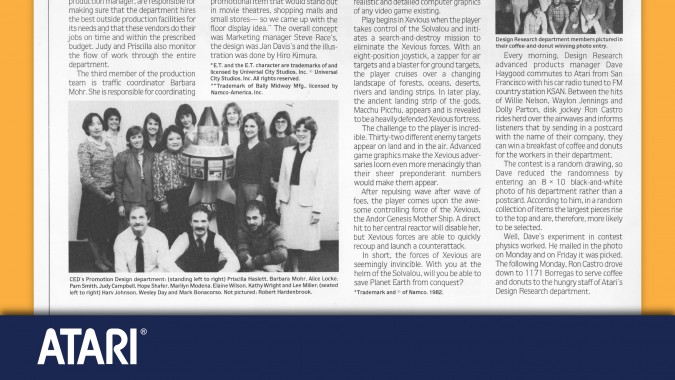
Did you ever meet Nolan Bushnell and Ted Dabney, if so please enlighten us?
No, I never met either of them. I worked for Atari between 1982-1984 and they were before my time. From what I understand, Bushnell and Dabney started Atari in 1972. Dabny left in 1973. Then, Warner Communications bought Atari in 1976 and Bushnell stayed on until 1979.
I wanted to meet the man who started Atari and had such an eccentric management style. His style was unusual for that time, it included encouraging odd hours and no dress code. I had even heard that he had a hot tub in his office.
After I was laid off from Atari for the first time, I went on an interview at Bushnell’s next business start-up, Chuck E. Cheese, the game and pizza chain. I was hoping to finally get a chance to meet him, but It wasn’t in the cards. I started back at Atari as a consultant a week later.
Please enlighten me what you knew about the Infamous ET game and it ending up buried in a landfill.
I truly thought, like most everyone else, that it was just an urban legend. The rumor circulating was that there was a mass burial of unsold video game cartridges, mostly E.T. the Extra-Terrestrial and PacMan cartridges along with consoles and computers in a New Mexico landfill site by Atari in 1983. However one day, over 30 years later, I was watching the evening news. The story was about a documentary being made called Atari: Game Over, and showed an excavation that revealed discarded games and hardware being dug up, that had been crushed and covered in cement. It turned out that the rumors were true after all!
I saw evidence of that when I spoke last year at the Portland Retro Gaming Expo. I was sitting at the autograph table next to Howard Scott Warshaw, who was the creator of the infamous E.T. game, along with one of the very best 2600 video games, Yars Revenge. One fan approached the table with a plastic bag. Inside was a crushed E.T. box covered with mud and pieces of crushed cement. He wanted Howard to sign it, and I believe he said he had bought it on EBAY.
What sort of jobs did you do freelancing and who for?
After Atari, I only worked on one package for the gaming industry after that. It was for the game Airheart for Broderbund Software, I still have the hand drawn maker comp I did for the backside. The final illustrations were done by Mitch Anthony.

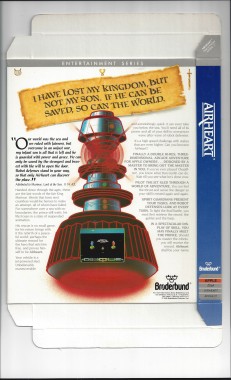
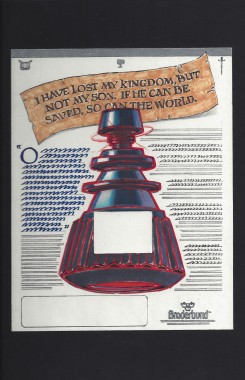
After that I freelanced on and off in-between full time jobs. I worked freelance for Silicon Valley greats such as Sun Microsystems, Hewlett Packard, Apple, and Borland. I eventually went back to designing in-house working for the high-tech companies. The Santa Cruz Operation (SCO) and Maxtor Corporation and eventually shifted into the Medical Device field and worked in-house for a start-up called Kyphon who was eventually bought by Medtronic, and most of the original people were let go.
Tell us what your currently working on?
Due to health issues, I have been taking a hiatus from working as a graphic designer, but hope to get better soon so I can get back to work. In the meantime I’m currently updating my PowerPoint presentation I did for my talk at the Portland Retro Gaming Expo, because I was asked to come back and speak again this year coming up in October.
I enjoy some modern games but feel more love for the smaller teams of the past I feel the fun factor has gone in modern games and are more like movie productions; games can be bug ridden now as patches can be made. in the past we didn’t have updates and in app purchases. What is your view of our industry now?
I agree with you. My jaw drops every time I see a commercial for the new games and see how realistic looking the graphics have become! But, to tell you the truth, I just got back into being interested in the gaming industry a few years ago. I am having fun catching up on what’s going on in the industry today.
I know this is a little bit off the subject, but I’ll give you some interesting background about how I got interested in gaming again after all these years. The “PBS, Antiques Road Show” came to my neighborhood in 2014, and my husband and I were lucky enough to attend. This is the american TV version of the BBC Antiques Roadshow.

I was interested in having my Atari promotional materials appraised. After two hours in the line for collectibles, I met James M. Supp of the Coronado Trading Company. He was very enthusiastic about the samples. He told me that there was a large, interested audience, that would probably love to see them. He also gave me an idea of the value of some of the pieces. I was quite surprised! After attending the show my interest was piqued.
My husband photographed my samples and made a PDF of them. He did a search online of people who were interested in buying retro games and original artwork. One of the people he found was Rick Weiss, and shared the PDF with him. After looking it over, Rick asked if I would be interested in being a presenter, and talk about what it was like to work at Atari. To my surprise, Rick turned out to be the president and one of the main organizers of the Portland Retro Gaming Expo.
The experience speaking and being at the expo was so eye opening! I had no idea retro gaming had become so popular again. Among the other speakers were Al Alcorn who designed Pong and Joe Decuir who was one of the original engineers who helped design, build, and produce the 2600 game console. I had never met them before. There was so much going on at Atari during the time I worked there that I didn’t know about. That’s because our Promotion/Design Department was isolated from the arcade and console programmers and game designers. But I am catching up fast!!!!!!
Here are some questions about retro games:
My favourite computer was my Amiga and 2 of my favourite games were Cannon Fodder and SWOS 🙂 and my favourite console the Megadrive do you have a favourite?
My favourite retro console is the Atari 2600.
What is your favourite retro game?
Ms Pac-Man of course! Even though it wasn’t originally written for for Atari. And it was the first game written specifically to entice women into the mostly male arcades. The Atari 2600 port of Ms Pac-Man was a much better game than the port of her male counterpart Pac-Man which was commercially successful by critically maligned. As I mentioned earlier in the interview, Ms Pac-Man was much closer to the arcade game.
Do you still game on the current consoles and if so whats your favourite game?
No, I haven’t gamed on the current consoles. But I’m excited to start doing research into which one I want to buy.
Finally what game or feature would you like to see on Retrogamesmaster in the future?
I was going to tell you that I would like to see you do a live interview. But, I think I saw a post of yours on Facebook or Twitter that you have one coming up.
Last, but not least. Did you ever meet Steve Jobs?
People always ask me that. No, he worked at Atari before me in 1974. At that time I was still in college in Southern California. I believe it was his job right before he took off on his spiritual journey to India.

